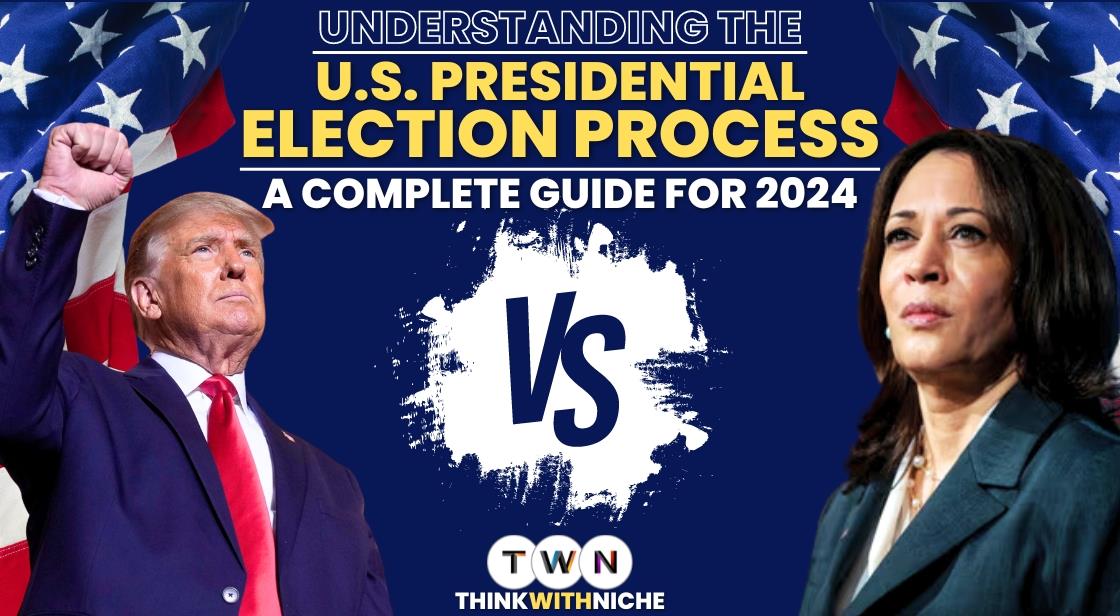Understanding the U.S. Presidential Election Process: A Complete Guide for 2024

Blog Post
As the United States prepares for the 2024 presidential election, the political landscape is charged with intense competition and high stakes. With former President Donald Trump aiming to return to the White House and Vice President Kamala Harris emerging as a formidable opponent, the race has never been more dynamic.
The election process, pivotal to American democracy, unfolds in distinct phases: from the primaries and caucuses that determine party nominees to the national conventions where these candidates are officially endorsed. The general election campaign follows, featuring debates and vigorous voter outreach efforts.
On November 5, 2024, voters will cast their ballots, but the ultimate decision will rest with the Electoral College, which will meet in December to formally elect the next president. If no candidate secures a majority of electoral votes, the House of Representatives will decide the outcome. The process culminates in the inauguration on January 20, 2025, marking the beginning of the next presidential term.
This comprehensive journey from candidate selection to inauguration underscores the complexity and significance of electing the leader of the free world.
As political tensions soar to unprecedented levels, understanding the intricate process of electing the next U.S. president is crucial.
This detailed journey highlights the complex and significant process of electing the leader of the United States.
United States Election Process Explained: How the Next President Will Be Elected
As the United States gears up for its next general election, the nation finds itself engulfed in a flurry of political debates, campaign rallies, fundraisers, endorsements, and nonstop social media discourse. All these activities are focused on determining who will become the next President of the United States.
Former President Donald Trump is optimistic about his chances of reclaiming the White House, but Vice President Kamala Harris presents a formidable challenge, intensifying the race to unprecedented levels. As political tensions reach their peak, here’s a comprehensive breakdown of how the U.S. will elect its next president.
Key Phases in the United States Election Process: The Journey to the White House
The U.S. presidential election is a multifaceted process that unfolds in several crucial stages: primaries and caucuses, national conventions, the general election campaign, and the Electoral College vote.
1. Understanding Primaries and Caucuses: January to June
The race for the White House began in early 2023, with candidates from both major parties announcing their intentions to run for president. On the Democratic side, Joe Biden initially emerged as the most prominent contender, while the Republican field saw Donald Trump competing against others such as Florida Governor Ron DeSantis, former U.N. Ambassador Nikki Haley, and Indian-American entrepreneur Vivek Ramaswamy.
Primaries and caucuses were held across all 50 states, the District of Columbia, and U.S. territories. These events are critical in determining the presidential nominees for the Democratic and Republican parties.
Leading in the polls since 2020, Trump was so confident in his nomination that he opted to skip all GOP debates. Nikki Haley gained some traction late in 2023, but none of Trump’s challengers could match his polling numbers, leading most to withdraw from the race.
In primary elections, registered voters cast ballots for their preferred candidate. Some states, like Iowa, use caucuses, which involve local meetings where party members vote for their candidate of choice. The results of these primaries and caucuses decide how many delegates each candidate will have at their party’s national convention. Delegates are representatives who pledge to support a specific candidate at the convention.
2. National Conventions: July to August
Following the primaries and caucuses, the Democratic and Republican parties typically hold their national conventions in the summer before the general election. These conventions are important political gatherings that include speeches, rallies, and the formal nomination of each party's candidates for president and vice president.
In the months leading up to the conventions, Joe Biden and Donald Trump enjoyed widespread support and were expected to be their parties' nominees. However, Biden faced growing concerns about his age and mental fitness, leading to a poor performance in a presidential debate against Trump. This prompted Biden to step aside, allowing Kamala Harris to become the Democratic candidate with strong endorsements from prominent figures like Barack Obama, Nancy Pelosi, and the Clintons.
Ahead of the conventions, presidential candidates announced their running mates. Kamala Harris selected Minnesota Governor Tim Walz, while Donald Trump chose Senator JD Vance. At the conventions, delegates formally cast their votes for the candidates, who then secured the majority of delegates to become the party’s nominee. Typically, the conventions are largely a formality, as the presumptive nominees usually secure enough delegates during the primaries.
Also Read: Must-See UNESCO Heritage Sites Around the World
3. The General Election Campaign: September to October
With the nominees confirmed, the general election campaign kicks into high gear. This phase involves intense campaigning across the nation, with candidates making their case to the American public through rallies, debates, advertisements, and social media outreach. The general election campaign is marked by several key activities:
-
Presidential Debates: These are pivotal moments in the campaign. This year, Trump and Harris have agreed to a debate on ABC News on September 10. The vice-presidential candidates, Vance and Walz, will debate on CBS News on October 1.
-
Voter Outreach: Campaigns invest heavily in grassroots organizing, phone banking, and get-out-the-vote drives to mobilize their supporters.
4. U.S. Election Day: November 5, 2024
Election Day occurs on the first Tuesday following the first Monday in November, when voters across the nation head to the polls to choose their preferred presidential candidates. This year, Election Day is set for November 5, 2024. However, unlike many other democracies, the U.S. president is not elected directly by the popular vote. Instead, the Electoral College plays a decisive role in determining the winner.
Understanding The U.S. Electoral College: A Unique System
The U.S. Electoral College is a distinctive and sometimes controversial aspect of the American election process. Each state is allocated a specific number of electors based on its representation in Congress, including two Senators and a varying number of Representatives based on state population. In total, there are 538 electors, and a candidate needs a majority of 270 electoral votes to win the presidency.
5. Electoral Vote: Counting in December 2024
Following Election Day, electors gather in their respective states in December to cast their electoral votes. These votes are then forwarded to Congress, where they are officially counted in early January. The candidate who receives the majority of electoral votes is declared the next president of the United States.
What Happens if No Candidate Wins a Majority?
In the rare event that no candidate secures a majority of the electoral votes, the election is decided by the House of Representatives. Each state delegation in the House casts one vote, and the candidate who receives a majority becomes president. The Senate selects the vice president in a similar manner.
6. Presidential Inauguration Day: January 20
The final stage in the election process is the inauguration, which takes place on January 20th of the year after the election. On this day, the president-elect is sworn into office by the Chief Justice of the Supreme Court and officially starts their four-year term.
Conclusion
In conclusion, the U.S. presidential election is a complex and multi-stage process that involves rigorous procedures and critical phases, each contributing to the ultimate selection of the nation’s leader.
From the early primaries and caucuses that set the stage for party nominations to the high-stakes general election campaign, and finally to the decisive role of the Electoral College, every step plays a crucial role in shaping the future of the country.
As the election approaches, candidates will continue to engage in intense campaigning, debates, and strategic maneuvers to secure the necessary support from voters and electors.
Understanding this intricate process is essential for voters and observers alike, as it highlights the unique features of American democracy and the significance of each stage in the journey to the White House.
As we anticipate the outcome of the 2024 election, staying informed about these processes ensures that we are better equipped to participate in and comprehend one of the most pivotal democratic events in the United States.
You May Like
EDITOR’S CHOICE












